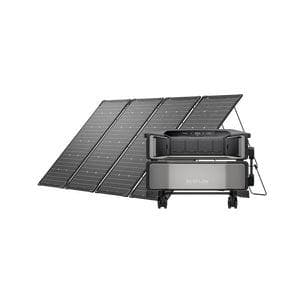Earth Day 2025: Our Power, Our Planet, Your Wallet
Earth Day: Good for the Planet, Great for Your Pocket
As we celebrate Earth Day 2025, this year’s theme—Our Power, Our Planet—asks us to think about where our energy comes from. It’s a crucial question, especially as many of us are realizing that our personal power choices have a huge impact on two things we care about deeply: the health of the planet, and the health of our bank account.
Let's be honest: when you look at your summer electric bill after weeks of running the air conditioner, the idea of "saving energy" becomes very personal. It’s no longer just an abstract good deed; it's a practical way to fight back against a major monthly expense.
This guide is about connecting those two powerful ideas. It will show you how the same actions that honor the theme of "Our Power, Our Planet" can also directly benefit your wallet and give you unshakable peace of mind.
Why Are Our Electric Bills So High in the US?
It’s not just your imagination; electricity costs are a serious concern nationwide. There are three major reasons why you're paying more, and understanding them is the first step to taking control.
(1) The "Rush Hour" for Electricity (Time-of-Use Rates)
In many states, especially places like California and Arizona, power companies are using Time-of-Use (TOU) pricing. Think of it like surge pricing for Uber. Between roughly 4 PM and 9 PM, when everyone is home from work and school, demand for electricity is at its peak. To manage this strain, utilities can charge a massive premium. Running your dishwasher or doing laundry during these hours can easily cost you double what it would cost late at night.
(2) An Aging Grid vs. Extreme Weather
Our nation's power grid is an incredible piece of engineering, but much of it is decades old. It’s now facing a new generation of challenges from extreme weather. This isn't a regional issue; it's happening everywhere, resulting in prolonged power outages. We see it in the hurricanes on the Gulf and East Coasts, the Public Safety Power Shutoffs (PSPS) during wildfire season in the West, and the brutal ice storms that have crippled states from Texas to Maine. Each event highlights the fragility of our grid and the high cost of repairs, which gets passed on to you.
(3) Volatile Natural Gas Prices
A huge portion of America's electricity is generated by burning natural gas. While it’s a domestic resource, its price can be incredibly volatile, swinging based on supply, demand, and global events. When gas prices go up, the cost to produce electricity goes up, and power companies pass that increase directly to consumers. This means your bill is often at the mercy of a market you have no control over.


How to Save Energy: From Simple Habits to Smart Tech
So, how can you fight back against these rising costs? It starts with simple changes and can lead to complete energy independence.
- Start with the Basics: Good habits make a real difference. Switch your remaining old lightbulbs to energy-efficient LEDs. Unplug electronics when you’re not using them to stop "phantom load"—the power they suck even when turned off. When it's time to replace an appliance, look for the Energy Star rating, which certifies it as a low-energy user.
- The Next Level: Clean Energy & Solar Power: While good habits help, the most powerful way to save money and gain independence is to create your own power. For most American homes, the most accessible and effective way to do this is with solar power. By capturing free energy from the sun, you can directly reduce your dependence on the expensive, unreliable grid.
Your 3-Step Home Energy Playbook
"Using solar power" sounds great, but what does it actually look like for your home, whether it’s a suburban house, a city apartment, or a rural property? This 3-step playbook will help you create a personalized plan.
Step 1: Find Your "Magic Number" (Calculate Your Needs)
First, you need a goal. You can't choose the right solution if you don't know what problem you're trying to solve. Grab a pen and paper and figure out your personal energy target.
Appliance's Power (Watts) × Hours of Use = Energy Needed (Watt-hours or Wh)
Think about two scenarios: a blackout, and your daily routine.
- For a Blackout: What absolutely must stay on? A refrigerator/freezer, your Wi-Fi router, a few lights, phone chargers, and any critical medical device (like a CPAP machine) are usually at the top of the list. If you have one, a sump pump or well pump is also essential.
- For Daily Savings: Which devices do you want to run on free solar energy? Maybe it's your home office setup, the living room TV and gaming console, or kitchen gadgets like the coffee maker and air fryer.
[Quick Example] Let's say your top priority is keeping the refrigerator (approx. 1500Wh/day) and Wi-Fi (10W x 24h = 240Wh) running during an outage. Your core energy target is 1500 + 240 = 1740Wh. This number is your key to picking the right gear.
Step 2: Define Your Primary Goal
Okay, you have your number. Now, let's find the perfect solution by asking one clear question to cover all the bases and avoid confusion.
Where will you use your power station MOST: At Home or On the Go?
Your answer to this single question will guide you down the right path.
If your answer is "At Home"
Your focus is on making your house more efficient and secure. Now, ask yourself a follow-up question: What's my #1 priority at home?
- Priority #1: Saving Money on Bills. If you're tired of those high peak-hour rates, this is you. Your strategy is to use an EcoFlow DELTA 2 to outsmart the utility company. You charge it with cheap nighttime power or free solar power, then run your evening appliances from stored energy.
- Priority #2: Never Losing Power. If your biggest fear is a blackout from a hurricane or ice storm, this is your goal. Your strategy is to use EcoFlow DELTA 2 as a home backup. Its EPS feature means it takes over instantly when the grid fails, so your home office, entertainment system, and essential appliances never even notice the switch.
If your answer is "On the Go"
Your focus is on freedom and adventure. You want power for RVing in a National Park, for a weekend of tailgating, for running power tools on a DIY project far from an outlet, or for camping with some modern comforts. This path leads directly to a unit designed for portability, like the EcoFlow RIVER 2.
Step 3: Pick Your Gear (Matching the Tool to the Job)
Now you can confidently choose your equipment.
For the "At Home" User
As we saw in Step 2, your focus on home savings or blackout protection points directly to the EcoFlow DELTA series. This series is engineered specifically for that job. It’s not just powerful, it’s built to last for the long haul. A key reason these units are ideal for home use is their durability; they are built with advanced LFP (LiFePO₄) battery technology, ensuring they can last for over a decade of regular use. With that reliability as a foundation, you can then choose the right size based on the "magic number" you calculated in Step 1. The DELTA 2 (1024Wh) is a great starting point for solid backup, and its capacity can be expanded with extra batteries if your needs grow."
For the "On the Go" User
Your focus on portability makes the EcoFlow RIVER series the obvious choice. It's light, easy to carry, and can be paired with portable solar panels (like a 100W-220W panel) to create an endless power cycle for your off-grid adventures.
The Benefits of Clean Power for Our Environment
Choosing a solar power solution like EcoFlow aligns perfectly with the Earth Day theme of "Our Power, Our Planet" by offering powerful environmental benefits.
Zero Operating Emissions: When your power station is running, it produces zero carbon dioxide and zero air pollutants. This helps improve local air quality in our communities and contributes to the larger fight against climate change.
Reduced Reliance on Fossil Fuels: Every bit of energy you generate from the sun is energy that doesn't have to be produced by a power plant burning natural gas or other fossil fuels. This fosters greater American energy independence and shrinks our collective carbon footprint.
A Quieter, Healthier Home: Unlike loud, fume-belching gas generators, solar generators are virtually silent. This eliminates noise pollution and, because they are fume-free, they are completely safe to use indoors during any kind of weather.
Safe for All Your Electronics: Beyond being environmentally clean, the power itself is 'clean'. Our solar generators produce a Pure Sine Wave, which is a steady stream of electricity identical to what you get from the wall. This clean output is essential for safely running sensitive electronics like laptops, game consoles, and modern appliances without risking damage.


Take Action: For the Planet, and For Yourself
We’ve gone from understanding the big picture of Earth Day to creating a concrete, personalized plan for your own home. You now know why your bills are high, what you can do about it, and how to choose the right tools for the job.
This Earth Day, your most effective action is one of smart self-reliance. By taking control of your power, you are achieving two incredible goals at once: you are saving money and securing your family's comfort, and you are making a powerful statement about the importance of clean, personal energy.
The time for worrying about high bills and potential blackouts is over. You have the playbook. It's time to take action—for your wallet, for your peace of mind, and for our planet.